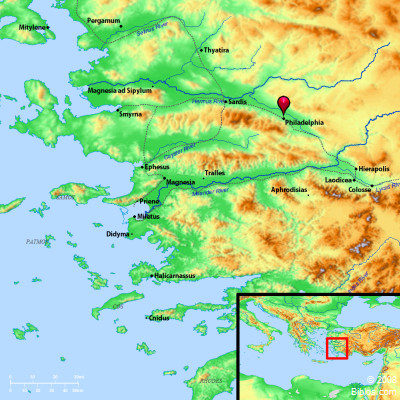Atlas  Philadelphia and surrounding region Maps Created using Biblemapper 3.0 Additional data from OpenBible.info You are free to use up to 50 Biblos coprighted maps (small or large) for your website or presentation. Please credit Biblos.com. Occurrences Revelation 1:11 saying, " What you see, write in a book and send to the seven assemblies : to Ephesus, Smyrna, Pergamum, Thyatira, Sardis, Philadelphia, and to Laodicea."Revelation 3:7 "To the angel of the assembly in Philadelphia write: "He who is holy, he who is true, he who has the key of David, he who opens and no one can shut, and who shuts and no one opens, says these things: Encyclopedia PHILADELPHIAfil-a-del-'fi-a (Philadelphia: A city of ancient Lydia in Asia Minor on the Cogamus River, 105 miles from Smyrna. It stood upon a terrace 650 ft. above the sea. Behind it are the volcanic cliffs to which the Turks have given the name of Devitt, or "inkwells"; on the other side of the city the land is exceedingly fertile, and there was produced a wine of whose excellence the celebrated Roman poet Virgil wrote. Philadelphia is not so ancient as many of the other cities of Asia Minor, for it was founded after 189 B.C. on one of the highways which led to the interior. Its name was given to it in honor of Attalus II, because of his loyalty to his elder brother, Eumenes II, king of Lydia. Still another name of the city was Decapolis, because it was considered as one of the ten cities of the plain. A third name which it bore during the 1st century. A.D. was Neo-kaisaria; it appears upon the coins struck during that period. During the reign of Vespasian, it was called Flavia. Its modern name, Ala-shehir, is considered by some to be a corruption of the Turkish words Allah-shehir, "the city of God," but more likely it is a name given it from the reddish color of the soil. In addition to all of these names it sometimes bore the title of "Little Athens" because of the magnificence of the temples and other public buildings which adorned it. Philadelphia quickly became an important and wealthy trade center, for as the coast cities declined, it grew in power, and retained its importance even until late Byzantine times. One of the Seven Churches of the Book of Revelation (Revelation 3:7) was there, and it was the seat of a bishop. As in most Asia Minor cities, many Jews lived there, and they possessed a synagogue. During the reign of Tiberius the city was destroyed by an earthquake, yet it was quickly rebuilt. Frederick Barbarossa entered it while on his crusade in 1190. Twice, in 1306 and 1324, it was besieged by the Seljuk Turks, but it retained its independence until after 1390, when it was captured by the combined forces of the Turks and Byzantines. In 1403 Tamerlane captured it, and, it is said, built about it a wall of the corpses of his victims. PHILADELPHIA, a city of Asia Minor, on the borders of Lydia and Phrygia, now called Alla-Shehr, or high city, with 3000 houses, about 15,000 pop., with few ancient ruins. It is nearly 70 ms. e. of Smyrna and about the same distance n.e. of Ephesus. It is elevated above the valley, on the n.e. slope of Mt. Tmolus. Strong's Greek G5359: PhiladelpheiaPhiladelphia, a city of Lydia |



